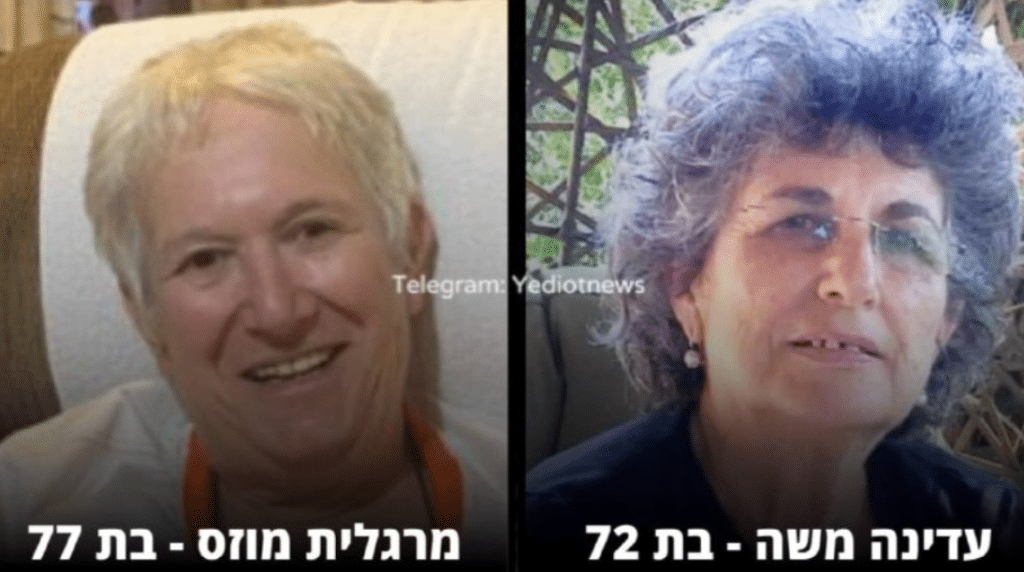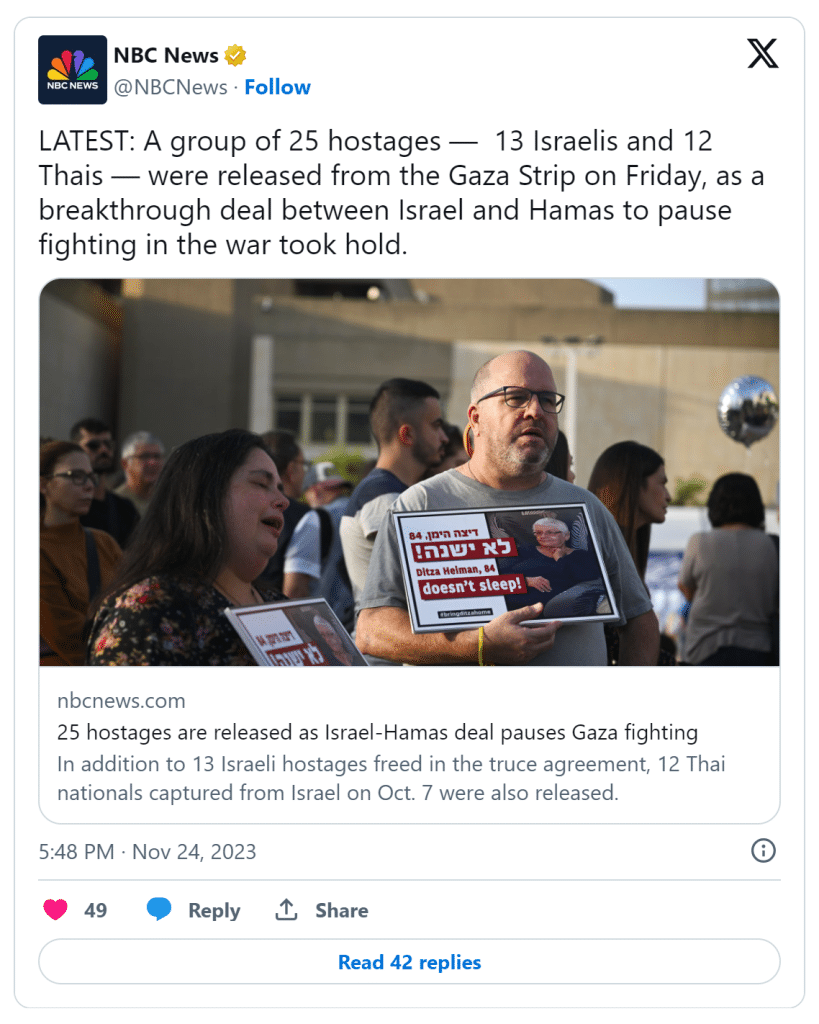13 Israeli Hostages Released
The list of the 13 Israeli hostages who were released is as follows:
Adina Moshe (72)
Margalit Moses (78)
Yafa Adar (85)
Hana Peri (79)
Daniel (45) and Emilia (5) Aloni
Ruti (78), Keren (54), and Ohad (9) Munder
Hana Katzir (77)
Doron (34), Raz (4.5), and Aviv (2.5) Katz Asher
The first phase of the hostage deal has begun, during which 13 women and children held in the Gaza Strip were released from Hamas captivity.
Also read: Palestinian Attackers Planned Systematic Sexual Assaults Against Israeli Women on October 7th
Adina Moshe, 72, and Margalit Moses, 77, residents of Nir Oz, were released after 49 days of captivity – the rest of the names of the 13 released hostages will be published later.

Emilia Aloni, 6 years old, and her mother Daniel Aloni, 34 years old, who were kidnapped from Nir Oz, were released from captivity in Gaza after 49 days.

Aviv Katz Asher, 2 years old, her sister Raz Katz Asher, 4 years old, and their mother Doron Katz Asher, 34 years old, who were kidnapped from Nir Oz, were also released from captivity in Gaza after 49 days.

They were transferred to the Red Cross in Khan Yunis and arrived in Egypt, from where they will be transferred to the Nitzana crossing at the border with Israel. According to the agreement, in the coming hours, 39 Palestinian prisoners from Ofer Prison will be released.

Red Cross teams received the 13 children and women who were released today (Friday) as part of the deal, after being held by the terrorist organization Hamas in the Gaza Strip since the outbreak of the war on October 7. The captives were transferred to the Red Cross in Khan Yunis, and taken to Egypt, from where they will be transferred to Israel through the Nitzana crossing – and will be received by IDF forces prepared to accompany them.
Video – First footage of the 13 Israeli hostages who were released at the Rafah crossing a few minutes ago
Operation Sky Doors
The operation to receive the captives was named ‘Operation Sky Doors’ by the IDF, and about two hours after the release of the captives from Gaza, near 18:00, 39 Palestinian prisoners will be released, who were transferred in the afternoon to Ofer Prison. The released Palestinians are 25 female prisoners and detainees and 14 minors, who were taken under heavy security from Damon Prison in Carmel and from Megiddo Prison to Ofer Prison near Givat Zeev, from where they will be released to the Judea and Samaria area and East Jerusalem.
The released captives will be transferred to Hatzor Air Base in four helicopters, three Yas’ur [Sea Stallion] and one Yanshuf [Black Hawk]. All returnees will receive special noise-cancelling headphones that were specifically purchased for them and are also suitable for children, with the aim of softening the flight experience and providing them with security and tranquility. Toys will also be distributed to the children. Each helicopter will carry a medical team from Unit 669, which will include a commander, three soldiers, and two treating physicians. Along with the returnees, representatives from the IDF’s Personnel Directorate will board, accompanying them throughout the process.
After being received by the IDF at the border crossing, the released individuals will be transferred, as mentioned, to Hatzor Air Base, where the abducted women will be received by female officers and caregivers. At Hatzor, they will undergo initial medical examinations and then make their first phone call to their families. Afterwards, they will be transferred, by minibus or helicopter depending on urgency, to five hospitals where they will be dispersed and meet with their family members. If one of the captives is in life-threatening condition upon arrival at Hatzor Air Base, they will be evacuated by a Yanshuf helicopter to Soroka Hospital.
According to the outline, a total of 50 captives will be released during the four days of the ceasefire. Hamas claims it ‘does not know’ where all the children and their mothers are, and therefore it is likely that during these days, 30 children and teenagers, eight mothers, and 12 adult women will be released. In addition to the ceasefire and the extensive entry of humanitarian aid and fuel, 150 Palestinian prisoners – boys and women – will be released in exchange for the release of the 50 captives, and this release is also expected to be carried out in stages.
According to the agreement, for every additional 10 captives that Hamas ‘finds’ and releases, it will receive an additional day of truce and the release of another 30 Palestinian prisoners and detainees. ‘I very much hope that more than 50 captives will be released, but I cannot commit to that,’ said Prime Minister Benjamin Netanyahu.
GRAPHIC WARNING October 7th Raw Video Footage
Credit: HamasVideo.com
How This All Started – October 7th Massacres
The Israel-Hamas War of 2023 began abruptly on October 7th, when Hamas orchestrated a comprehensive land, sea, and air assault on Israel from the Gaza Strip. This attack, coinciding with the Jewish holiday of Shemini Atzeret, caught many by surprise, especially as many IDF soldiers were on leave.
The assault was unprecedented in its scale, launching over 2,200 rockets in 20 minutes, breaching the border with explosives and bulldozers, and even infiltrating via motorboats and paragliders.
This devastating attack resulted in over 1,200 deaths, multiple instances of sexual violence and rape, mutilations, kidnappings of babies, women and children and various other atrocities perpetrated on Israelis by the Palestinian attackers and mobs, marking it as the deadliest day for Israel since its independence.
In response, the IDF declared a state of alert and began mobilizing its reserves, calling up more than 350,000 over the following days. By October 8th, Israel had declared itself in a state of war, the first time since the Yom Kippur War in 1973.
Air strikes were initiated in the Gaza Strip, and a total siege was imposed, cutting off essential supplies. The war saw the difficulty in targeting terrorists and their weapon caches due to Gaza’s intricate network of tunnels, complicating rescue efforts for the hostages taken by Hamas.
While the war primarily centered on the Gaza Strip, it wasn’t confined to it. IDF intensified its raids in the West Bank and conducted airstrikes for the first time since the second intifada. Skirmishes with Hezbollah near the Lebanese border raised fears of a second front.
Even the Houthi forces in Yemen attempted strikes on southern Israel, indicating a broader coordination among Iran-led resistance factions.

